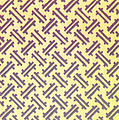博文
Wallpaper group:平面群 vs 空间群?
|||
关注:
1) 表面的一些常见术语
Wallpaper group
A wallpaper group (or plane symmetry group or plane crystallographic group) is a mathematical classification of a two-dimensional repetitive pattern, based on the symmetries in the pattern.
Such patterns occur frequently in architecture and decorative art. There are 17 possible distinct groups.
Wallpaper groups are two-dimensional symmetry groups, intermediate in complexity between the simpler frieze groups and the three-dimensional crystallographic groups (also called space groups).
A symmetry of a pattern is, loosely speaking, a way of transforming the pattern so that the pattern looks exactly the same after the transformation. For example, translational symmetry is present when the pattern can be translated (shifted) some finite distance and appear unchanged. Think of shifting a set of vertical stripes horizontally by one stripe. The pattern is unchanged. Strictly speaking, a true symmetry only exists in patterns that repeat exactly and continue indefinitely. A set of only, say, five stripes does not have translational symmetry — when shifted, the stripe on one end "disappears" and a new stripe is "added" at the other end. In practice, however, classification is applied to finite patterns, and small imperfections may be ignored.
Sometimes two categorizations are meaningful, one based on shapes alone and one also including colors. When colors are ignored there may be more symmetry. In black and white there are also 17 wallpaper groups; e.g., a colored tiling is equivalent with one in black and white with the colors coded radially in a circularly symmetric "bar code" in the centre of mass of each tile.
The types of transformations that are relevant here are called Euclidean plane isometries. For example:
If we shift example B one unit to the right, so that each square covers the square that was originally adjacent to it, then the resulting pattern is exactly the same as the pattern we started with. This type of symmetry is called a translation. Examples A and C are similar, except that the smallest possible shifts are in diagonal directions.
If we turn example B clockwise by 90°, around the centre of one of the squares, again we obtain exactly the same pattern. This is called a rotation. Examples A and C also have 90° rotations, although it requires a little more ingenuity to find the correct centre of rotation for C.
We can also flip example B across a horizontal axis that runs across the middle of the image. This is called a reflection. Example B also has reflections across a vertical axis, and across two diagonal axes. The same can be said for A.
However, example C is different. It only has reflections in horizontal and vertical directions, not across diagonal axes. If we flip across a diagonal line, we do not get the same pattern back; what we do get is the original pattern shifted across by a certain distance. This is part of the reason that the wallpaper group of A and B is different from the wallpaper group of C.
Examplesp2 (p211): Primitive cell, 2-fold rotation symmetry, no mirrors or glide reflections.
p4g (p4gm): Primitive cell, 4-fold rotation, glide reflection perpendicular to main axis, mirror axis at 45°.
cmm (c2mm): Centred cell, 2-fold rotation, mirror axes both perpendicular and parallel to main axis.
p31m (p31m): Primitive cell, 3-fold rotation, mirror axis at 60°.
Here are all the names that differ in short and full notation.
| Short | p2 | pm | pg | cm | pmm | pmg | pgg | cmm | p4m | p4g | p6m |
|---|---|---|---|---|---|---|---|---|---|---|---|
| Full | p211 | p1m1 | p1g1 | c1m1 | p2mm | p2mg | p2gg | c2mm | p4mm | p4gm | p6mm |
The remaining names are p1, p3, p3m1, p31m, p4, and p6.
Orbifold notation: 4*2.
Lattice: square
Point group: D4
The group p4g has two centres of rotation of order four (90°), which are each other's mirror image, but it has reflections in only two directions, which are perpendicular. There are rotations of order two (180°) whose centres are located at the intersections of reflection axes. It has glide reflections axes parallel to the reflection axes, in between them, and also at an angle of 45° with these.
A p4g pattern can be looked upon as a checkerboard pattern of copies of a square tile with 4-fold rotational symmetry, and its mirror image. Alternatively it can be looked upon (by shifting half a tile) as a checkerboard pattern of copies of a horizontally and vertically symmetric tile and its 90° rotated version. Note that neither applies for a plain checkerboard pattern of black and white tiles, this is group p4m (with diagonal translation cells).
https://wap.sciencenet.cn/blog-567091-738197.html
上一篇:典型及非典型的分子结构
下一篇:感悟之:review report与writing a paper
全部作者的其他最新博文
全部精选博文导读
相关博文
- • Minerals线下恳谈会:履践致远、与时偕行——对话中国科学院广州地球化学研究所期刊合作学者
- • 聚英才 建高地 | 北京理工大学“特立青年学者”全球招聘开启
- • 700年后日本或濒临灭绝?日本学者推算预测:届时或仅剩1名15岁以下孩子
- • [转载]【同位素视角】非英语母语学者如何区分’e.g.’, ‘i.e.’, ‘namely’与‘such as’等混淆难题
- • 美国佐治亚大学等机构学者:刈割策略对Bulldog 805紫花苜蓿+Tifton 85狗牙根混播草地产量及品质的影响
- • 美国堪萨斯州立大学、密苏里大学等机构学者研究成果:土壤水分管理策略和品种多样性对紫花苜蓿产量、营养品质和农场盈利能力的影






